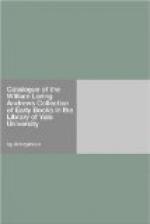Seventy-two leaves, including the five blanks, are wanting in this copy, viz.: sign. a-C; 1, 1, 4, 5, 8; 2, 1, 4, 5; 3, 2; 4, 1; 27, 3; [28*,2]; 44, 7; 50-55. The lacking parts comprise the first twenty leaves (Prohemye and alphabetical index), the last forty leaves (Caxton’s eighth book), and twelve intermediate leaves. Of these the Proheyme is supplied in facsimile and sign. 4, 1 in manuscript. What is possibly an original impression of Caxton’s large device is placed at the end of the volume. This was used by Caxton only during his last years, 1487-91, and by Wynkyn de Worde, into whose hands the original block passed, in his folios for thirty years longer. From one of the latter this may have been taken, possibly from the Polychronicon of 1495, where the other side of the leaf it occupied was blank, as is the case here also.
Trevisa’s translation of Higden was completed, according to the best MSS., in 1387, not in 1357 as stated on fol. 389^b. (In 1357 the 18th of April fell on Tuesday, not Thursday, and Thomas Lord Berkeley was then in the fifth, not the thirty-fifth year of his age.) Caxton was himself the translator of twenty-two of the one hundred books which he printed and it was therefore not strange that Trevisa’s English should have been in his hands, as the proem states, “a lytel embelysshed fro tholde makyng.” In what these embellishments consisted is partially explained in the epilogue: “Therfore I William Caxton a symple persone haue endeuoyred me to wryte fyrst ouer all the sayd book of proloconycon, and somewhat haue chaunged the rude and old Englyssh, that is to wete certayn wordes, which in these dayes [1482] be neyther usyd ne understanden”. He went however further than this and so changed the inflections and orthography that the language is no longer of the fourteenth but rather of the fifteenth century. But in no other way could it have been made to harmonize with his proposed continuation,




